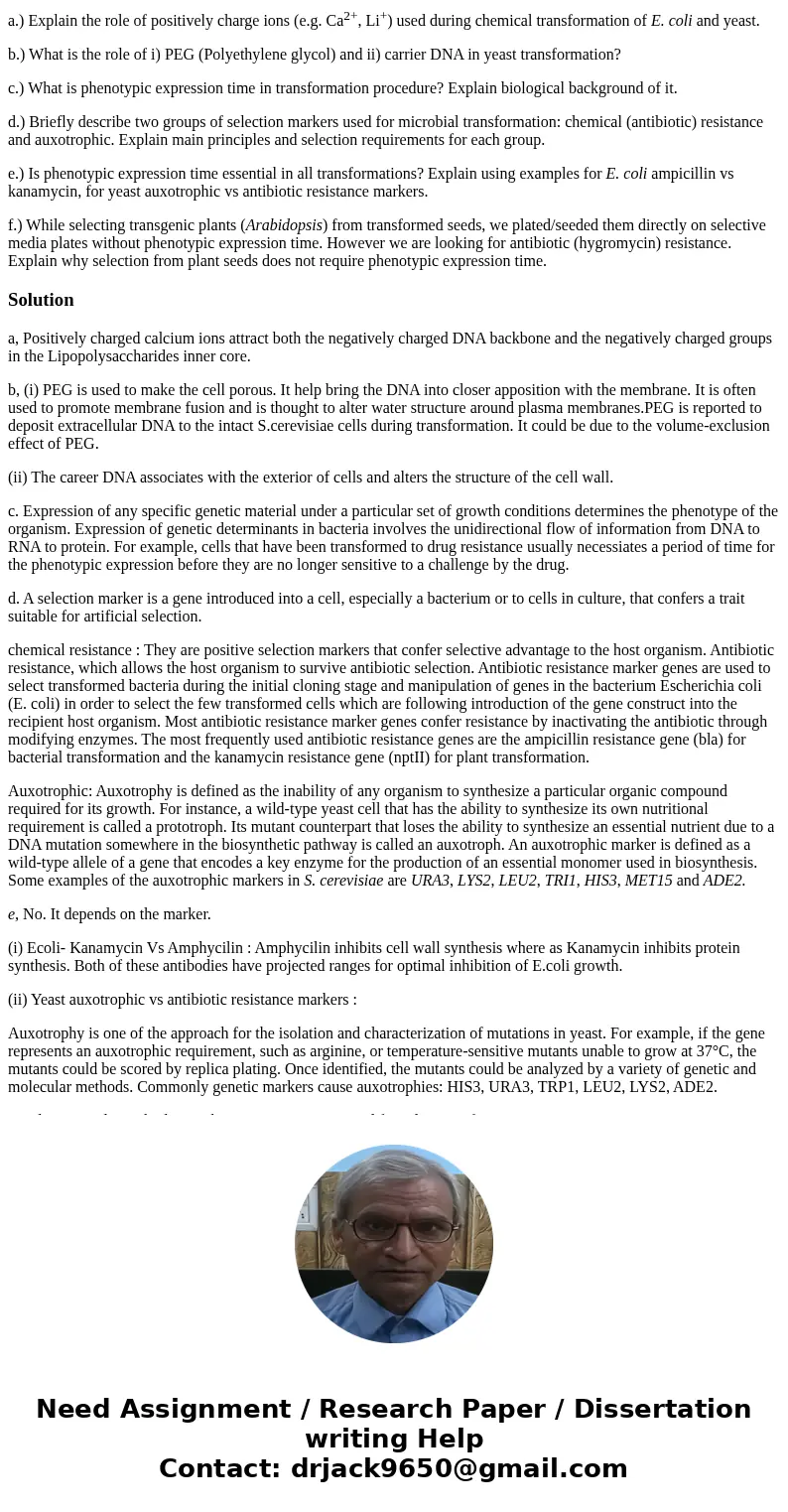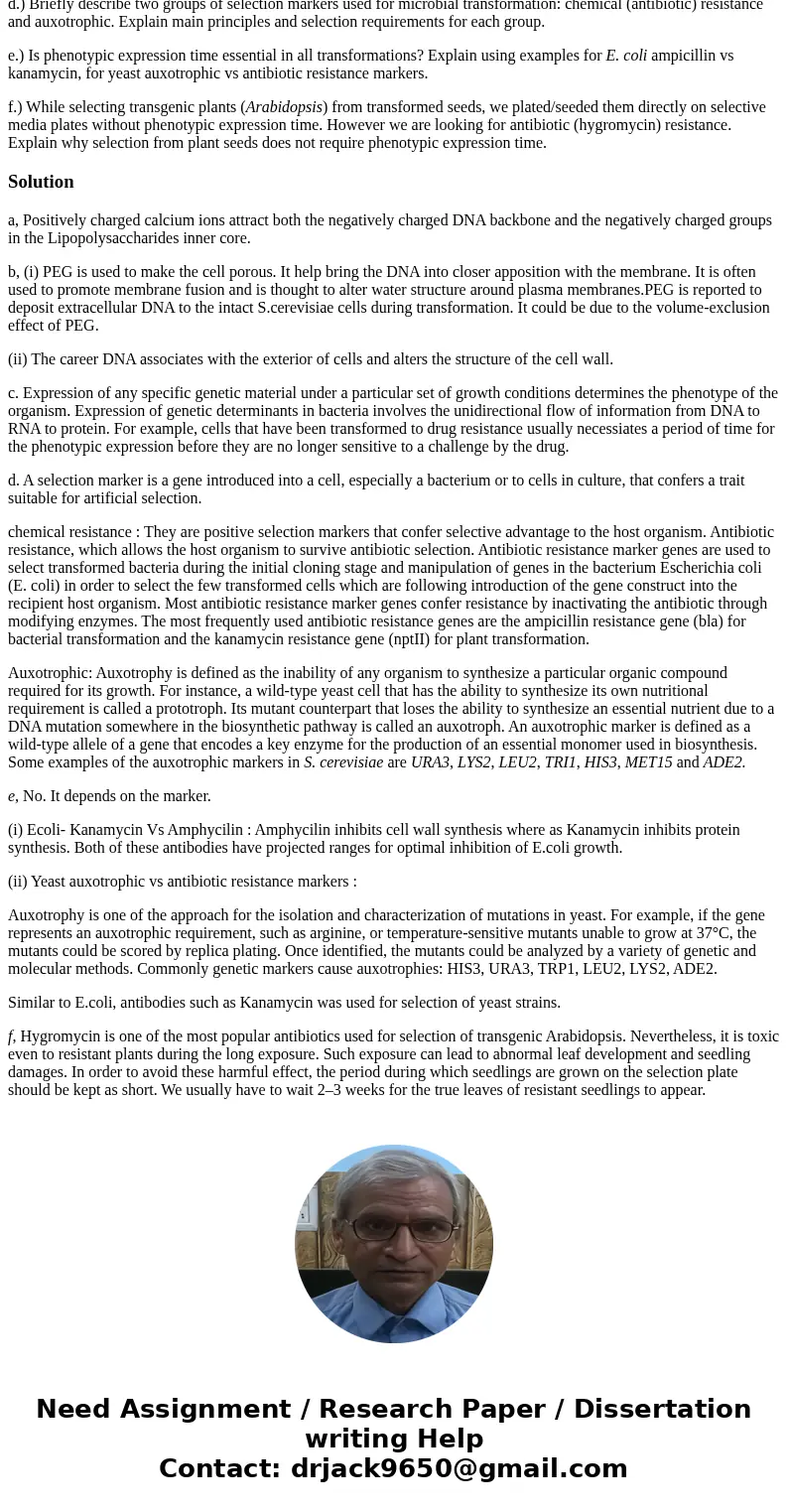a Explain the role of positively charge ions eg Ca2 Li used
a.) Explain the role of positively charge ions (e.g. Ca2+, Li+) used during chemical transformation of E. coli and yeast.
b.) What is the role of i) PEG (Polyethylene glycol) and ii) carrier DNA in yeast transformation?
c.) What is phenotypic expression time in transformation procedure? Explain biological background of it.
d.) Briefly describe two groups of selection markers used for microbial transformation: chemical (antibiotic) resistance and auxotrophic. Explain main principles and selection requirements for each group.
e.) Is phenotypic expression time essential in all transformations? Explain using examples for E. coli ampicillin vs kanamycin, for yeast auxotrophic vs antibiotic resistance markers.
f.) While selecting transgenic plants (Arabidopsis) from transformed seeds, we plated/seeded them directly on selective media plates without phenotypic expression time. However we are looking for antibiotic (hygromycin) resistance. Explain why selection from plant seeds does not require phenotypic expression time.
Solution
a, Positively charged calcium ions attract both the negatively charged DNA backbone and the negatively charged groups in the Lipopolysaccharides inner core.
b, (i) PEG is used to make the cell porous. It help bring the DNA into closer apposition with the membrane. It is often used to promote membrane fusion and is thought to alter water structure around plasma membranes.PEG is reported to deposit extracellular DNA to the intact S.cerevisiae cells during transformation. It could be due to the volume-exclusion effect of PEG.
(ii) The career DNA associates with the exterior of cells and alters the structure of the cell wall.
c. Expression of any specific genetic material under a particular set of growth conditions determines the phenotype of the organism. Expression of genetic determinants in bacteria involves the unidirectional flow of information from DNA to RNA to protein. For example, cells that have been transformed to drug resistance usually necessiates a period of time for the phenotypic expression before they are no longer sensitive to a challenge by the drug.
d. A selection marker is a gene introduced into a cell, especially a bacterium or to cells in culture, that confers a trait suitable for artificial selection.
chemical resistance : They are positive selection markers that confer selective advantage to the host organism. Antibiotic resistance, which allows the host organism to survive antibiotic selection. Antibiotic resistance marker genes are used to select transformed bacteria during the initial cloning stage and manipulation of genes in the bacterium Escherichia coli (E. coli) in order to select the few transformed cells which are following introduction of the gene construct into the recipient host organism. Most antibiotic resistance marker genes confer resistance by inactivating the antibiotic through modifying enzymes. The most frequently used antibiotic resistance genes are the ampicillin resistance gene (bla) for bacterial transformation and the kanamycin resistance gene (nptII) for plant transformation.
Auxotrophic: Auxotrophy is defined as the inability of any organism to synthesize a particular organic compound required for its growth. For instance, a wild-type yeast cell that has the ability to synthesize its own nutritional requirement is called a prototroph. Its mutant counterpart that loses the ability to synthesize an essential nutrient due to a DNA mutation somewhere in the biosynthetic pathway is called an auxotroph. An auxotrophic marker is defined as a wild-type allele of a gene that encodes a key enzyme for the production of an essential monomer used in biosynthesis. Some examples of the auxotrophic markers in S. cerevisiae are URA3, LYS2, LEU2, TRI1, HIS3, MET15 and ADE2.
e, No. It depends on the marker.
(i) Ecoli- Kanamycin Vs Amphycilin : Amphycilin inhibits cell wall synthesis where as Kanamycin inhibits protein synthesis. Both of these antibodies have projected ranges for optimal inhibition of E.coli growth.
(ii) Yeast auxotrophic vs antibiotic resistance markers :
Auxotrophy is one of the approach for the isolation and characterization of mutations in yeast. For example, if the gene represents an auxotrophic requirement, such as arginine, or temperature-sensitive mutants unable to grow at 37°C, the mutants could be scored by replica plating. Once identified, the mutants could be analyzed by a variety of genetic and molecular methods. Commonly genetic markers cause auxotrophies: HIS3, URA3, TRP1, LEU2, LYS2, ADE2.
Similar to E.coli, antibodies such as Kanamycin was used for selection of yeast strains.
f, Hygromycin is one of the most popular antibiotics used for selection of transgenic Arabidopsis. Nevertheless, it is toxic even to resistant plants during the long exposure. Such exposure can lead to abnormal leaf development and seedling damages. In order to avoid these harmful effect, the period during which seedlings are grown on the selection plate should be kept as short. We usually have to wait 2–3 weeks for the true leaves of resistant seedlings to appear.


 Homework Sourse
Homework Sourse